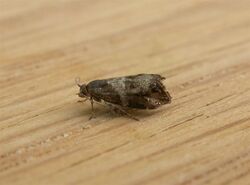Biology:Tebenna micalis
| Tebenna micalis | |
|---|---|

| |

| |
| Scientific classification | |
| Domain: | Eukaryota |
| Kingdom: | Animalia |
| Phylum: | Arthropoda |
| Class: | Insecta |
| Order: | Lepidoptera |
| Family: | Choreutidae |
| Genus: | Tebenna |
| Species: | T. micalis
|
| Binomial name | |
| Tebenna micalis (Mann, 1857)
| |
| Synonyms | |
| |
Tebenna micalis, also known as the small thistle moth, is a species of moth in the family Choreutidae found worldwide.[1] It was first described by the German Bohemian entomologist, Joseph Johann Mann in 1857.
Description
The wingspan is about 13 millimetres (0.51 in).[2] It is similar in appearance to the Nearctic Tebenna gnaphaliella and can be found between June and August. It comes to light and can be found during the day on the flowers of the larval foodplant.
The larvae feed on Asteraceae within a blotch, sometimes leaving the mine and starting another. Later instars can live freely in a web on the leaf.[3] Larval foodplants recorded include, on common fleabane (Pulicaria dysenterica) in the United Kingdom.[2] In Australia on capeweed (Arctotheca calendula), spear thistle (Cirsium vulgare), horseweed (Erigeron canadensis), cotton thistle (Onopordum acanthium) and golden everlasting (Xerochrysum bracteatum); and in Réunion on globe artichoke (Cynara scolymus).[1][4] They mine the leaves of their host plant in a sizable blotch with an ample quantity of frass. The larva may leave its mine and restart elsewhere. Older larvae often live free in a web on the leaf.[3]
Larvae pupate on the underside of a leaf of the host plant, in a spindle-shaped cocoon.[3]
Distribution
In Europe it is found south of the line Ireland, Great Britain, France and Slovakia. In Britain it is an immigrant that occurs irregularly, since it was first discovered in the 1980s. Outside of Europe, it has been recorded from China (Henan, Hubei, Jiangxi, Tibet, Zhejiang), Nepal, Russia , Japan (Honshu, Ryukyu Islands), Afghanistan, Tajikistan, Uzbekistan, Turkmenistan, Canary Islands, North Africa, Arabia, Asia Minor, Zakavkazye, Iran, Lebanon, New Zealand, and the Oriental, Ethiopian, Australia n and Nearctic regions.
Subspecies
- Tebenna micalis micalis
- Tebenna micalis dialecta Diakonoff, 1985 (Madagascar, Mauritius, Namibia and South Africa)
References
- ↑ 1.0 1.1 Don Herbison-Evans & Stella Crossley (January 27, 2009). "Tebenna micalis". uts.edu.au. Archived from the original on September 26, 2009. https://web.archive.org/web/20090926172321/http://www-staff.it.uts.edu.au/~don/larvae/chor/micalis.html. Retrieved 2009-02-18.
- ↑ 2.0 2.1 Ian Kimber (January 1, 1998). "Tebenna micalis". ukmoths.org.uk. https://ukmoths.org.uk/show.php?id=4893. Retrieved 2009-02-18.
- ↑ 3.0 3.1 3.2 Ellis, W N. "Tebenna micalis (Mann, 1857) vagrant metal-mark". https://bladmineerders.nl/parasites/animalia/arthropoda/insecta/lepidoptera/ditrysia/apoditrysia/choreutoidea/choreutidae/tebenna/tebenna-micalis/. Retrieved 14 October 2020.
- ↑ De Prins, J. & De Prins, W. 2014. Afromoths, online database of Afrotropical moth species (Lepidoptera). World Wide Web electronic publication (www.afromoths.net) (09.Apr.2014)
Wikidata ☰ Q1351432 entry
 |

